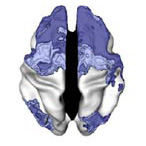Welcome to Encephalon, the bi-weekly neuroscience blog carnival. In the 36th Edition, you will learn what STDs have to do with Alzheimer’s, how rats plan their decisions in a maze and why kids start speaking in nouns. Thanks for all the great submissions.
Brain Disease
 Zachary Tong at Distributed Neuron reports on new evidence that neural progenitor cells migrate towards the site of strokes. Researchers injected progenitor cells into mouse brains and then induced artificial strokes in half the subjects. They tracked the progenitor cells and found direct migration of labeled cells in the animals with brain injury.
Zachary Tong at Distributed Neuron reports on new evidence that neural progenitor cells migrate towards the site of strokes. Researchers injected progenitor cells into mouse brains and then induced artificial strokes in half the subjects. They tracked the progenitor cells and found direct migration of labeled cells in the animals with brain injury.
Zachary also investigates the diverse genetic causes for epilepsy. New research demonstrates that disparate mutations associated with the disease can cancel each others’ negative effects when co-expressed.
Evil Monkey at Neurotopia provides yet another reason to practice safe sex: avoiding Alzheimer’s Disease (AD). Herpes virus HSV-1 is a risk factor for AD and may accelerate the formation of amyloid plaques associated with cognitive decline.
Relatedly, Sandra Kiume at Channel N links to videos about memory loss from a conference at the University of British Columbia. The videos discuss tips for healthy aging in the context of cutting edge neuroscience research.
Computational Neuroscience
 Jake Young at Pure Pedantry highlights a great paper in J. Neuroscience about how spatial information is encoded in the hippocampus. The authors made electrophysiogical recordings from rats as they chose between two alternative arms of a maze. These recordings revealed transient activation of neurons associated with each path, even before the rat embarked on either of them. This research proves that hippocampal maps are not solely for real-time encoding of spatial location but also for projections about future position.
Jake Young at Pure Pedantry highlights a great paper in J. Neuroscience about how spatial information is encoded in the hippocampus. The authors made electrophysiogical recordings from rats as they chose between two alternative arms of a maze. These recordings revealed transient activation of neurons associated with each path, even before the rat embarked on either of them. This research proves that hippocampal maps are not solely for real-time encoding of spatial location but also for projections about future position.
In a related — albeit more theoretical — vein, Michael introduces his new blog Shared Symbolic Storage with a post about embodied cognition. Michael mentions a paper co-authored by Benoit Hardy-Vallée, an Encephalon contributor.
Imaging Studies
 Ed Yong at Not Exactly Rocket Science reviews new research showing that the brains of children with attention deficit hyperactivity disorder (ADHD) exhibit delayed maturation of the prefrontal cortex and accelerated maturation of the primary motor cortex. The findings are encouraging because they suggest that the brains of patients with ADHD eventually catch with those of nonaffected individuals.
Ed Yong at Not Exactly Rocket Science reviews new research showing that the brains of children with attention deficit hyperactivity disorder (ADHD) exhibit delayed maturation of the prefrontal cortex and accelerated maturation of the primary motor cortex. The findings are encouraging because they suggest that the brains of patients with ADHD eventually catch with those of nonaffected individuals.
The Neurocritic has a great two part takedown of the New York Times’ latest foray into pseudoscience. He links to several rebuttals and contributes a healthy dose of common sense with this rhetorical question: “Did we really need fMRI to tell us that Mrs. Clinton should try to soften the negative responses of swing voters?”
Language

Michael at Shared Symbolic Storage offers a three part review of Baboon Metaphysics, a new book by Dorothy Cheny and Robert Seyfarth. The authors propose that social cognition preceded and made possible the emergence of language, instead of vice versa. Michael argues that this proposal neglects the mechanisms though which language can in turn influence our thought.
“Mama,” “Cookie,” “Nap.” Why do children learn nouns like these before other parts of speech? Dave Munger at Cognitive Daily reports on a creative study in which infants learning their first language were compared to older children learning a second language. This allowed researchers to figure out whether the early abundance of nouns is a function of age or an necessary feature of language acquisition.
That wraps it up for this issue of Encephalon. Bora at A Blog Around the Clock hosts Encephelon #37 on December 3rd. Email your posts to encephalon{dot}host{at}gmail{dot}com or submit using the online form.
 Wired Science has a good post about Complete Genomics, a new company that promises to sequence an entire human genome for a mere $5000. This is approximately 5% of the current price tag.
Wired Science has a good post about Complete Genomics, a new company that promises to sequence an entire human genome for a mere $5000. This is approximately 5% of the current price tag.

 That’s why we turned to a company called
That’s why we turned to a company called 
 Zachary Tong at Distributed Neuron
Zachary Tong at Distributed Neuron  Jake Young at Pure Pedantry
Jake Young at Pure Pedantry  Ed Yong at Not Exactly Rocket Science
Ed Yong at Not Exactly Rocket Science 



 Kevin Everett, a tight end for the Buffalo Bills, was seriously injured a week ago. Immediately after hitting an opponent in a routine tackle, Everett
Kevin Everett, a tight end for the Buffalo Bills, was seriously injured a week ago. Immediately after hitting an opponent in a routine tackle, Everett